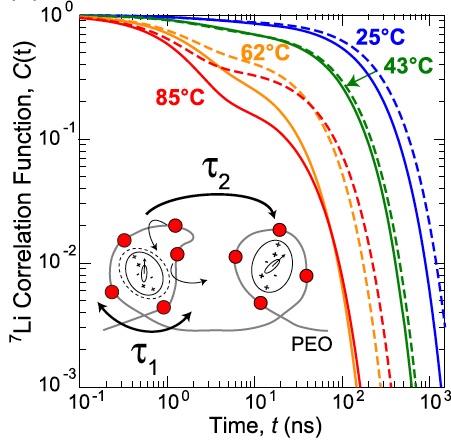Ask for a reprint
email :
* Give your email
2017
ACL
|
T.V.Huynh, R.J.Messinger, V.Sarou-Kanian, F.Fayon, R.Bouchet, M.Deschamps, 'Restricted lithium ion dynamics in PEO-based block copolymer electrolytes measured by high-field nuclear magnetic resonance relaxation', J. Chem. Phys. 147 134902 (2017) doi:10.1063/1.4993614
The intrinsic ionic conductivity of polyethylene oxide (PEO)-based block copolymer electrolytes is often assumed to be identical to the conductivity of the PEO homopolymer. Here, we use high-fi�eld 7Li nuclear magnetic resonance (NMR) relaxometry and pulsed-�field gradients (PFG) NMR di�usion measurements to probe lithium ion dynamics over nanosecond- and millisecond scales in PEO and polystyrene (PS)-b-PEO-b-PS electrolytes containing the lithium salt LiTFSI. Variable-temperature longitudinal (T1) and transverse (T2) 7Li NMR relaxation rates were acquired at multiple magnetic �eld strengths and analyzed collectively for the �rst time, enabling us to distinguish two characteristic timescales that describe fluctuations of the 7Li quadrupolar interaction
while accounting for atomic vibrations on the electric �eld gradient. Fast (O(ns) and shorter) lithium motions are essentially identical between the two polymer electrolytes, including sub-nanosecond vibrations and local fluctuations of the coordination polyhedron between lithium and nearby oxygen atoms. However, lithium dynamics over longer time scales (O(10 ns)) are slower in the block copolymer compared to the homopolymer, as manifested experimentally by their di�fferent transverse 7Li NMR relaxation rates. Restricted dynamics of PEO chains anchored near PS domains and nonuniform LiTFSI concentrations within the PEO lamellae may explain these results.
|

|